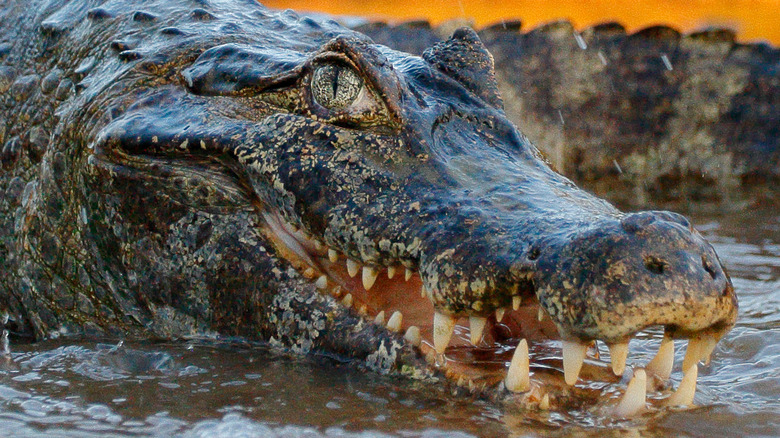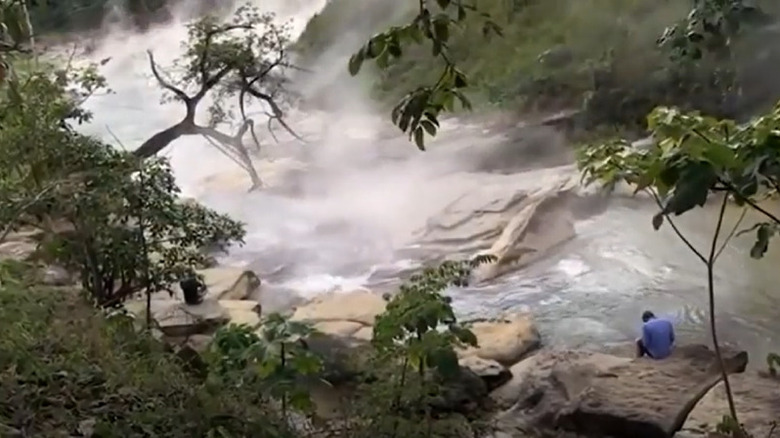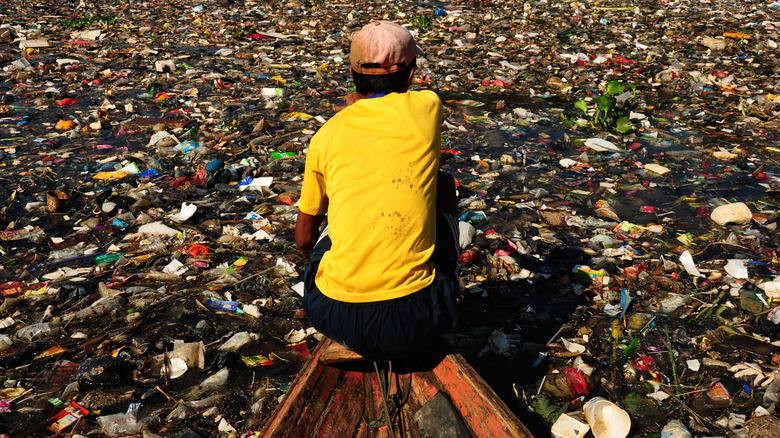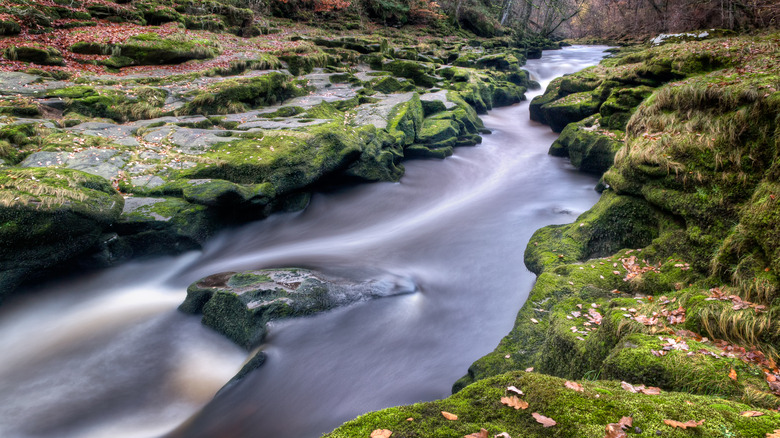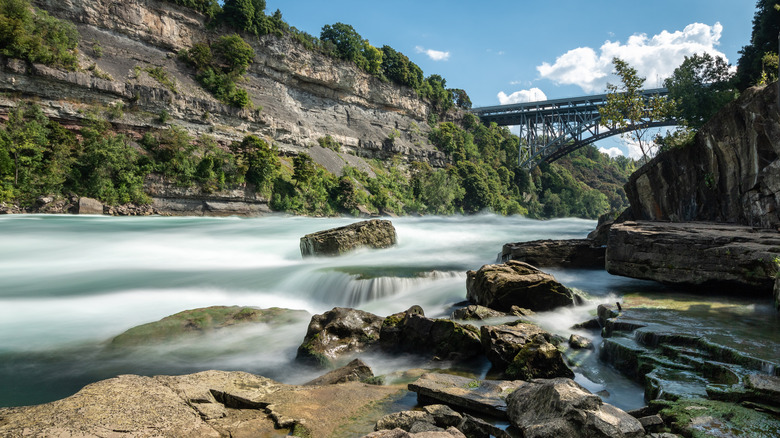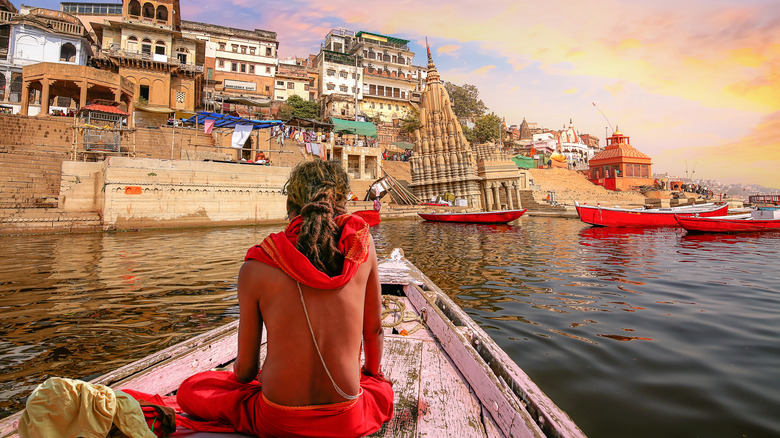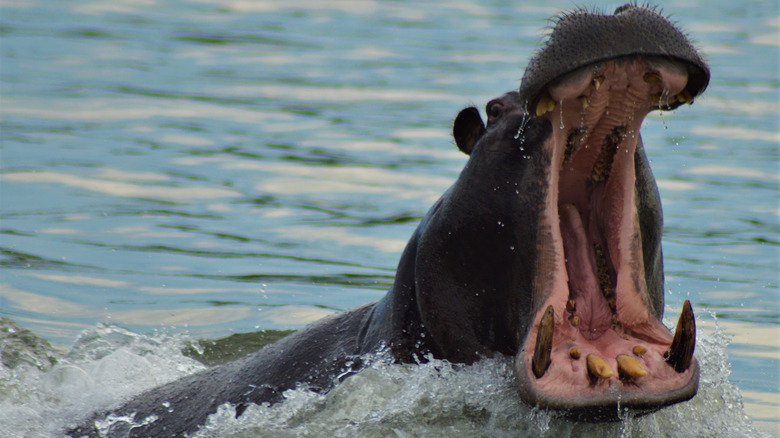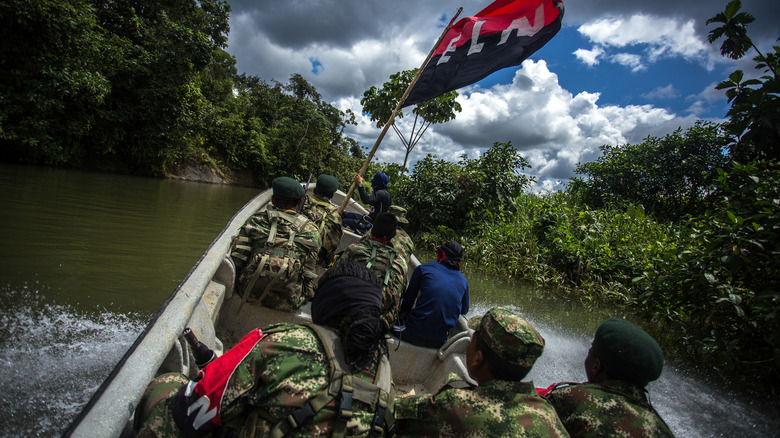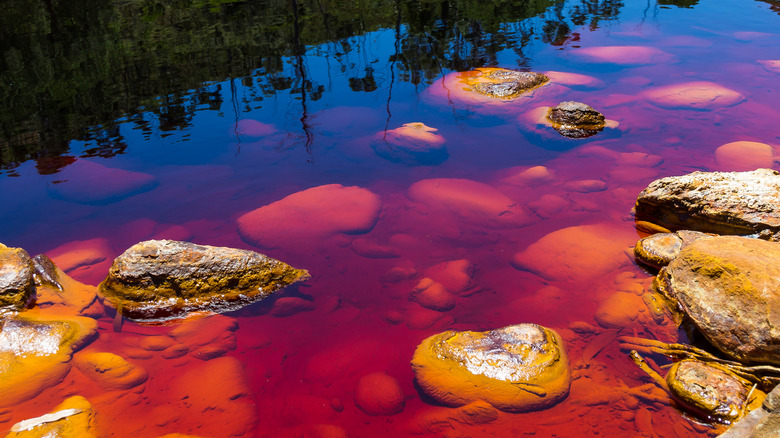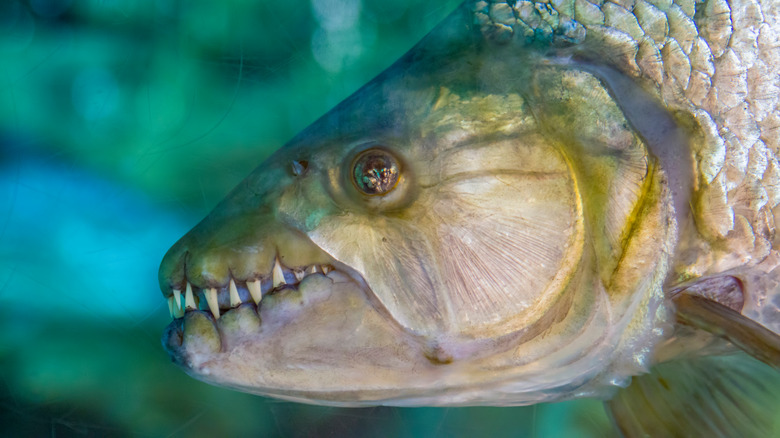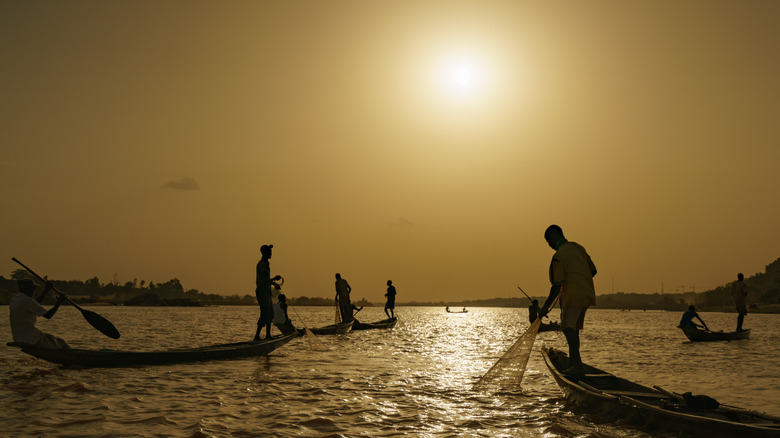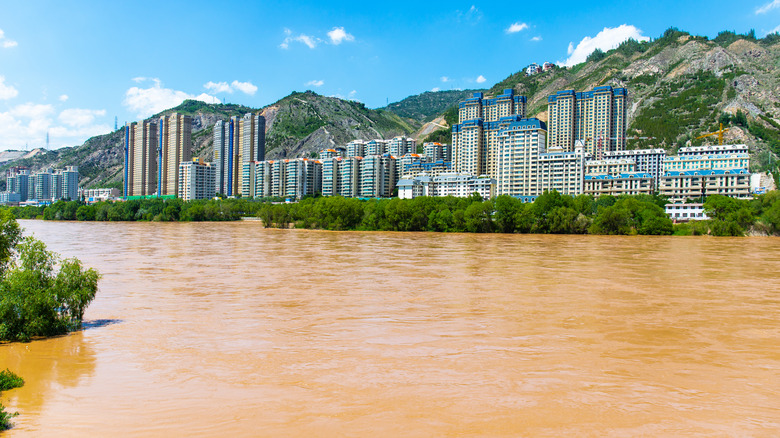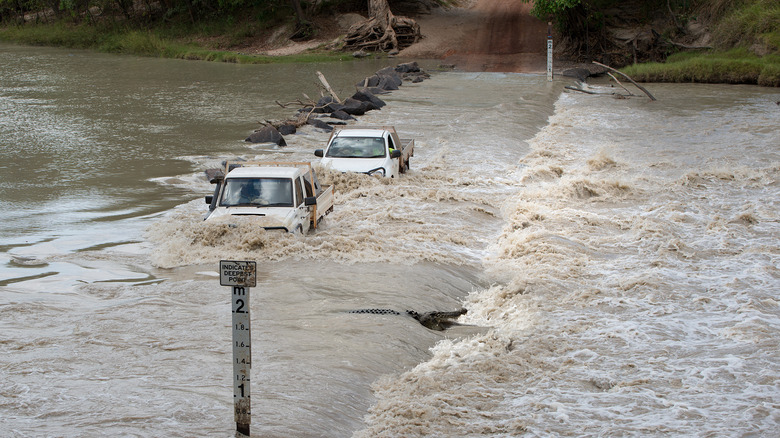The Most Dangerous Rivers On The Planet
Water is one of the most insanely powerful forces on the planet, and should absolutely not be ignored. There's an old bit of wisdom, after all, that says you should never turn your back on the ocean, and there's a reason for that. Rivers are something a little different, though, and we tend not to think of them as being as scary as a vast ocean home to some seriously terrifying forces and phenomenon. But take a look at some of our mythology, and it quickly becomes clear that our ancestors gave rivers a healthy amount of respect.
Icy Sedgwick says that British folklore, for example, has a creature called Jenny Greenteeth. She's a grindylow, and she lives in rivers and waits to grab unwary children. Peg O'Nell was said to live in the Ribble and require regular sacrifices, lest she take a human life... and people regularly sacrificed to the spirits of Sheffield's rivers, too. The Rhine in Germany had a siren named Lorelei tempting travelers to their deaths, and ancient Greeks had the rivers of the underworld: Styx, Acheron, Cocytus, Phlegethon, and Lethe.
While those are all mythological, let's look at some very real rivers that are even deadlier than some of the myths.
Peru's Boiling River will definitely cook creatures alive
Andres Ruzo has a PhD in geophysics, and when he started asking people who were theoretically "smarter" and "more experienced" if it was possible there was any truth to the old myth about a boiling river deep in the Peruvian jungles, most laughed at him. One even said, "Stop asking stupid questions, it's making you look bad."
Those smart people were completely and absolutely wrong.
Ruzo found the very real river, and according to National Geographic, it's in the middle of the Peruvian Amazon. It's a tributary of the Amazon River, and Ruzo found that while the temperature varied quite a bit, it regularly got up to around 200 degrees Fahrenheit — hot enough to boil animals (and burn humans) unfortunate enough to fall in. The source of heat is water flowing from hot springs into the river, and it turns out those so-called smart people were completely oblivious to something the local communities of the Amazon had known about for a long time. Ancient beliefs say that every location along the river — which is typically only visited by shamans — is the home to a different spirit, like the serpent Yacumama (which births hot and cold waters), and the Spirit of the Vapor, which carries the prayers of the faithful to the world's creator.
The world's most toxic river is killing those around it
There's around nine million people that live near the Citarum River in Indonesia, and that's a lot of people who rely on the waterway for things like drinking water, fishing, and irrigation. Unfortunately, it's also one of the most polluted rivers in the world, and the sheer scale of the pollution is almost unthinkable.
The Guardian says that anyone who approaches the river will walk through a smell so strong it's almost tangible — and it's the smell of "rubbish rotting in hot sun mixed in with an acrid tone of chemical waste." The chemical waste is a byproduct of the more than 2,000 industrial buildings along the river and local residents who have no other way to get rid of their garbage. That's resulting in shocking levels of everything from heavy metals like iron and aluminum to levels of fecal bacteria that are thousands of times higher than maximum limits set up by environmental protection agencies.
Predictably, that's led to a ton of problems that include things like abnormally high rates of tumors, chronic bronchitis, tuberculosis, intestinal and renal problems, dermatitis, and delayed development in children. While attempts are being made to clean up the river, it's an uphill battle hampered by issues like a lack of cooperation from companies still dumping their waste in the river, and a system of bribery that's allowed them to keep doing it.
England's most dangerous river looks deceptively tranquil
The Bolton Strid (which is a section of the River Wharfe) is only an average of about six feet wide, and as it flows through the Yorkshire woods, it burbles along pretty peacefully... on the surface. According to locals (via The New York Times), the warning signs along the river are there for a very good reason: Some claim the river has a kill rate of 100%.
So, what's going on here? As the river runs along, there's a section where it goes from about 30 feet across and fairly shallow to just six feet across and very, very deep. Under the surface of the river is a deep chasm, pocketed with caverns, craggy rocks, and overhangs where unsuspecting swimmers can easily find themselves swept — and trapped.
It's not clear just how many lives the river really has claimed, but it was mentioned in a William Wordsworth poem from the early 1800s, and deaths still happen: In 2020, The Yorkshire Post warned it took the life of an 18-year-old man. Emergency services regularly patrol the area and try to dissuade swimmers who underestimate the strong undercurrents, deadly rocks, and potentially shock-inducing cold water.
In 1896, Gertrude Atherton described the river like this: "There was no lonelier spot in England, nor one which had the right to claim so many ghosts, if ghosts there were."
The falls aren't the only deadly drops along the Niagara River
According to NY Falls, more than 5,000 bodies have been recovered from the base of the falls since 1850, and that's a statistic that's only climbing — only partially because of the falls themselves. The Niagara River is full of deadly phenomena, including the Niagara Whirlpool. Info Niagara says it formed somewhere around 4,200 years ago, and it's 125 feet deep. For reference, that's an 11-story building, and history is full of tragic stories of people who died along the Whirlpool and nearby rapids. In 1913, a 9-year-old and an 11-year-old boy were swept to their deaths: Onlookers reported (via The New York Times) "the boys realized all hope was gone ... [and] one of the boys waved his hand in farewell to those on the shore."
Some claim there's more at work at Niagara. Way back in 1678, the first white man to see the Falls wrote, "The temptation to throw one's self down this incredible precipice is almost too great for resistance," and people have been saying similar things for centuries. According to the National Post, countless people have been seen jumping — or wading — into the river only to keep going, and modern research posits a reason why.
Now, it's believed the combination of height, noise, and rushing water can cause a short-circuit in the brain. Our fear signals go off so urgently that we don't know how to interpret them, and instead of backing up, we jump... whether we want to, or not.
India's most sacred river is also one of the most polluted
The Ganga (or Ganges) River, says PBS, is a sacred river that is a lifeline for nearly half a billion people. It's not just used for ritual bathing, funeral pyres, and as a soul-cleansing pilgrimage, it's a source of drinking water, and water for everything from irrigation to use in India's many, many factories. It's also one of the most toxic rivers in the world.
The kind of pollution that fills the Ganga isn't visible to the naked eye: It comes thanks to the millions and millions of tons of raw sewage that get dumped into the waters every day (in addition to animal waste and runoff from farms that includes fertilizers and pesticides). That's been cited as one of the causes of India's chronic problem with illnesses like cholera, and outbreaks that kill somewhere around 1.5 million kids a year.
That's just part of the problem. According to The New York Times, the Ganga has been so polluted for so long that it's become a breeding ground not just for bacteria, but for antibiotic-resistant bacteria. Recent research shows that up to 70% of bacteria present in hospital patients is now resistant to the most commonly administered drugs, and researchers are scrambling to figure out where they're coming from. A likely culprit? The hundreds of thousands of tourists that converge on the river during annual pilgrimage-vacation season.
Sharks, and landmines, and hippos... oh, my!
Louis Greeff did the unthinkable in 2013: he took his bodyboard the 1,800 mile-length of the Zambezi River. When he wrote about it for The Guardian, he included a laundry list of dangers that started with the estimated 90,000 hippos and 188,000 crocodiles that lived along the river, continued with a ton of unexploded landmines, and ended with strong currents and river sharks. (Locals thought he was nuts, and there was a $22,000 bet riding on whether or not he'd finish. He did — three months later.)
Those are just some of the dangers presented to those who are travelling along the river, but what about those who live there? According to Bloomberg, the effects of climate change are very quickly making life along the Zambezi a daily, life-or-death struggle, starting with dropping water levels that kill scores of fish and destroy the crops usually irrigated by the river. It's estimated that about half of all protein consumed by those living along the Zambezi comes from fish, but in 2019, entire swaths of fishing grounds were dry. In other areas, unpredictable weather patterns led to rising waters and flooding, killing hundreds of people in Mozambique and destroying around 300,000 acres of crops.
The entire unpredictability of the river in the face of climate change was best summed up by a fisherman named Abraham Kasenga: "Without the Zambezi, I'm poor. I have no work. I have nothing."
This Colombian river is owned by the drug traffickers
In 2018, The Guardian visited a school along the San Juan River. There, community members gathered to pay tribute to those who had "been 'disappeared,' murdered, silenced, and displaced." What's going on there is insanely complicated, but here's the basics: the San Juan River is one of the major drug-trafficking routes through Colombia, and there are several groups fighting for control.
Human Rights Watch named the National Liberation Army and the Gaitanist Self-Defense Forces of Colombia as two of the biggest armed groups vying for control of the San Juan River and the area surrounding it, citing methods like child recruitment, intimidation, revenge killings, kidnapping, the spread of landmines, and outright violence for being responsible for forcing thousands of people to flee their homes. At the same time, Express & Star got a look at what it was like to travel along the river, and it involved regular military checkpoints and the threat of violence that could erupt at any moment.
There's another layer to what's going on here, too: the cocaine moved along this 240-mile-long river was then used to fund a civil war that — in 2018 — had killed around 220,000 people, with another 80,000 counted among the missing.
The river that's so similar to the surface of Mars, it's used for scientific experiments
Once mankind learned how to start working with various types of metals, it ushered in a whole new phase of human history. According to the BBC, the metal- and mineral-rich areas of what's now called Spain are thought to be some of the first places that happened, and mining operations have been carried out there from about 3000 BC to 2001.
And that's how a 30-mile stretch of the Rio Tinto came to be so acidic and so filled with heavy metals that while you definitely wouldn't want to swim there, there's another use for it: simulating the surface of Mars. The river contains several things — like an iron and potassium sulfate compound, and a ton of methane — that have also been found on Mars, which got the attention of astrobiologists trying to basically figure out how to recognize alien life if — and when — they see it.
Researchers from the University of Hull say (via The Conversation) that red rivers like the Rio Tinto (and rivers that occasionally turn red thanks to chemical spills, like a Siberian river that went red in 2016) have some serious environmental consequences that include killing local wildlife to speeding up natural processes like erosion. Oh, and there's the whole public health issue of releasing a ton of toxic heavy metals into the water supply, and... someone's going to sort that out, right?
No matter who you are, men with machetes are always terrifying
In 2012, Phil Harwood recounted a ridiculous journey for The Guardian: he had become the first person to canoe all 3,000 miles of the Congo River. It's harrowing stuff, so here's the very abbreviated version of some of the dangers he faced along the way: men with machetes, crocodiles, hippos, massive rapids, waterfalls, snakes, super scary fish, armed rebels, spiders (and spider webs the size of houses), and, well, let's sum it up like this. In 1877, Henry Morton Stanley set out along the Congo, and when the last surviving European member of his team drowned, he wrote, "I am weary, oh so weary, of this constant tale of woes and death."
There's obviously a lot that makes the Congo River dangerous, so let's talk about two of the most chilling. First, there's the Gates of Hell. MongaBay says this particular part of the river is essentially a 75-mile-long stretch that runs through a canyon that not only makes escaping the river pretty iffy, but it also creates a stretch of "impassable rapids." (As if that's not enough, there's also a 60-miles stretch of rapids near Stanley Falls, and another stretch that's an insane 220 miles long.)
Then, there's a swath of the lower Congo that's nicknamed "the abattoir." Why? It was once a hotspot of cannibalistic activity, and it's currently a hotbed of criminal activity.
Flooding of the Niger is devastating millions
The numbers are insane: From 2012 to 2017, the BBC says that around 2.5 million people were forced to leave their homes during severe flooding of the Niger River. Record-setting high levels have killed hundreds more, destroyed huge sections of farmland, and killed countless livestock animals.
What's going on here is a complicated pile of problems resulting from abnormally heavy rains, dams that are unable to handle the water, and poor town planning that put residential areas right smack dab in flood zones.
It seems like it's only getting worse. In 2020, Al Jazeera reported that flooding had forced another 226,000 people to leave their homes, even as structures across the country collapsed in the flood waters. According to The New Humanitarian, that's just part of the problem. Pollution is also a major concern, along with the spread of invasive plants like the water hyacinth, the slow decline of fish populations, and frequent cholera outbreaks that kill hundreds of people each and every year.
China's aptly-named River of Sorrow
National Geographic says that the Yellow River is China's second-longest, and also adds that the yellow silt that it carries makes for some seriously fertile farmland. That silt is also part of the problem, though, and for thousands of years, those that live along the river have tried — and failed — to tame it.
The Yellow River was first settled back around 2100 BC, and it's impossible to tell how many have died in the frequently-occurring flood waters. We do know, however, that it was a constant problem: Da Yu is a figure thought to be largely mythological, who's credited for helping protect villages and crops from flooding in a way that allowed the valley to be settled.
No one has ever really been able to keep the river under control, and China Highlights says that between 608 BC and 1938, there have been more than 1,500 recorded floods, and the river has changed course a wild 26 times. Millions have died, and the worst flood happened in 1887. More than 15,000 square kilometers were suddenly underwater as the river rose and dams burst, and between the flooding and the disease that followed, it's estimated that around two million people died in that flood alone. According to the Environment and Society Portal, floods from the Yellow River have killed more people than floods from the rest of the planet's rivers combined.
Australia's croc crossing
People lose their lives all the time doing stupid things, whether it's recreating some stunt they saw on YouTube or trying for the perfect selfie. In 2019, one Australian woman got the ire of the internet when someone else shared a picture of her sitting in the water at Cahills Crossing, a drink in hand and a complete obliviousness to the fact that there were crocodiles right there. Literally. Like... right there. She later said (via Yahoo!), "Everyone keeps saying, 'didn't you see the signs?' Yes, [I did], but everywhere has signs up here." Apparently she Googled the location afterwards and realized that yes, those signs are there for a reason, so the moral of the story is: Do your research, folks.
News.com.au says that Cahills Crossing — which is on the East Alligator River, the first danger clue — is one of the most dangerous waters in the country for two reasons: it's packed with man-eating crocodiles, and people are incredibly dumb. A 2016 survey counted an average of 120 crocs in a 4-miles stretch of the river, but people still insist on trying to drive across the crossing, fishing in the river, or even wading in with their children.
Yes, people have died there — including a 47-year-old man who was killed in 2017, and a man who was decapitated by a croc in 1987 — so... maybe, just stay out of the water, okay?
